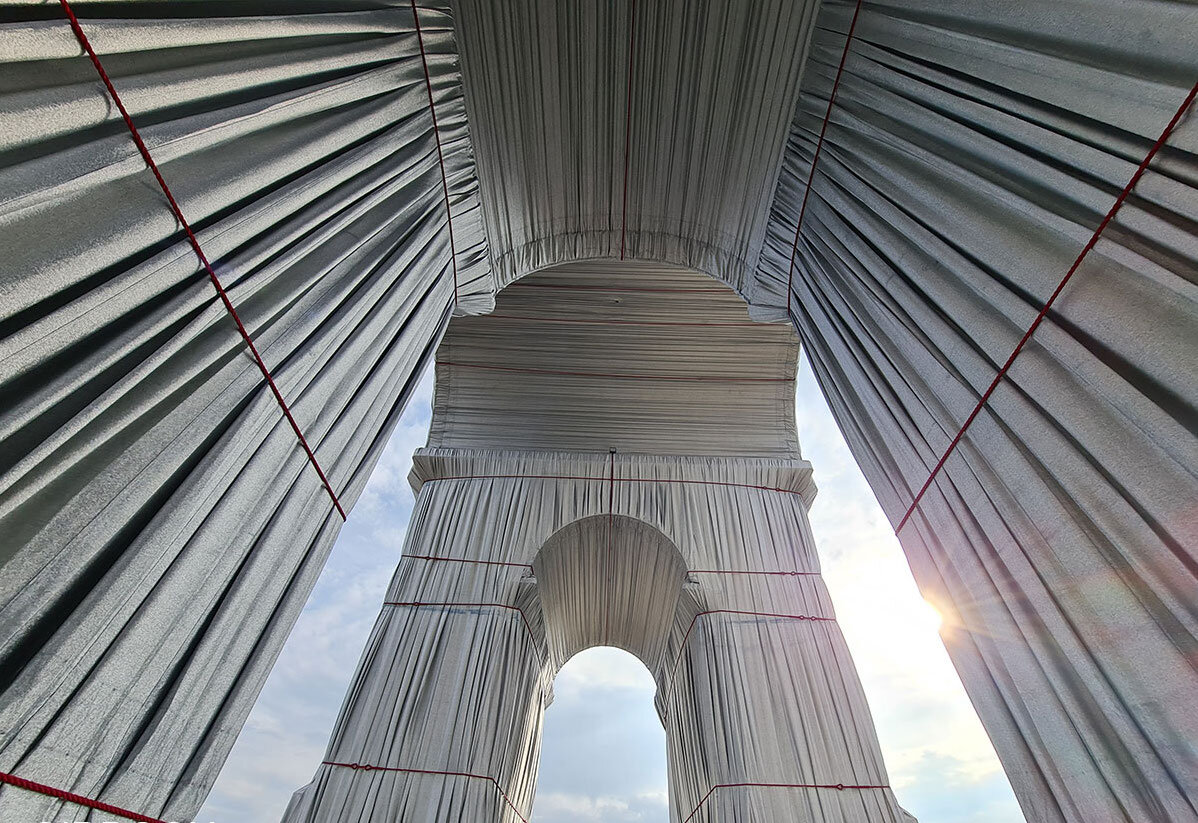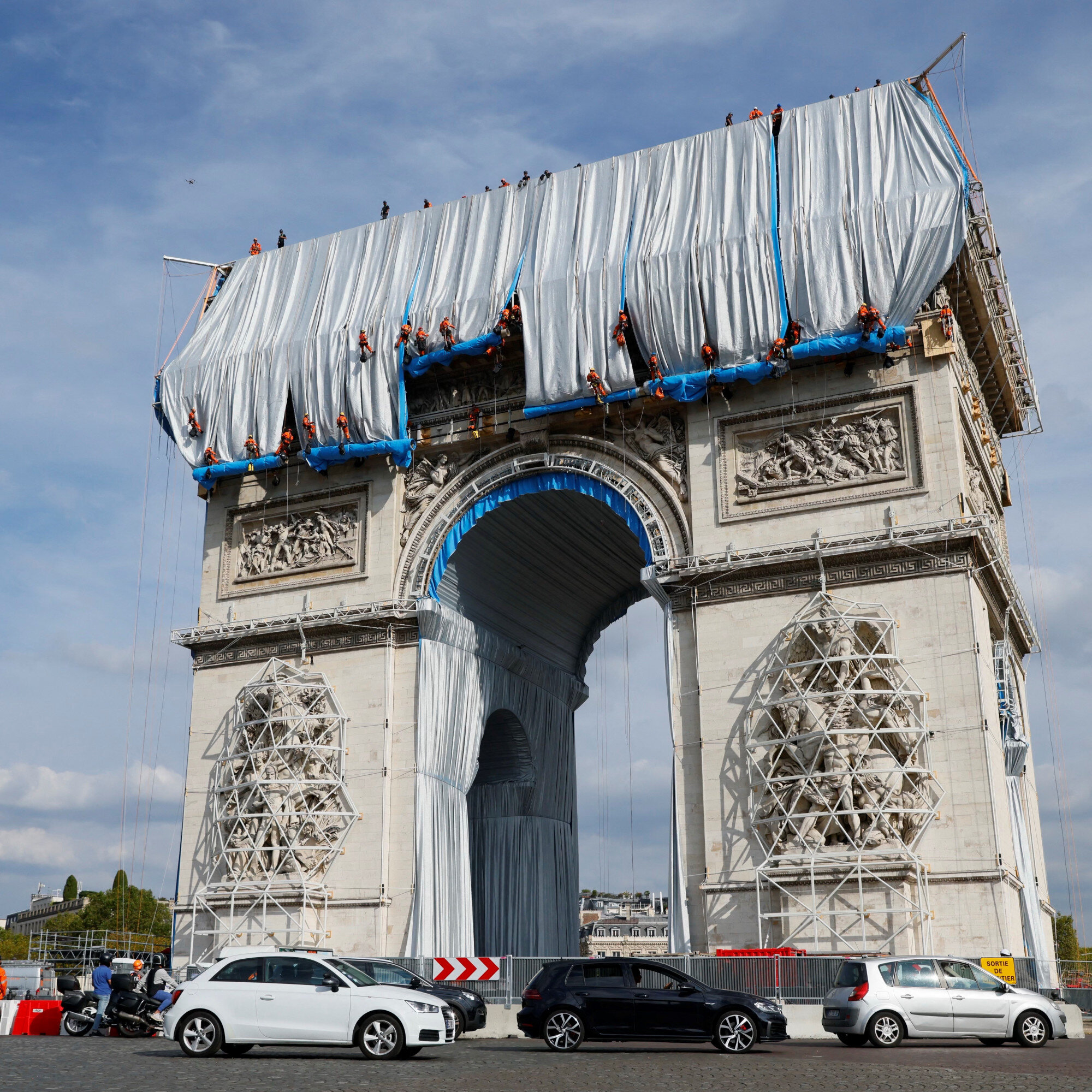The Final Wrap
Christo & Jeanne Claude and the Arc de Triomphe, September 2021
Last summer I wrote about the Christo & Jeanne-Claude exhibition at the Pompidou. You can read it here: https://www.museemusings.com/home/its-a-wrap To get right to the wrapping, (and skip Christo’s early life and art), begin reading right after Figure 12.
But now let’s talk about Christo and Jeanne Claude’s ‘Arc de Triomphe Wrapped’ which I saw twice last week. (Figure 1) On Sunday, the day after it opened to the public and on Monday, when I walked up the 284 steps inside the arch to get onto the wrapped roof.
I went on Sunday because it was sunny and I wanted to see the arch when the sky was only partly filled with clouds. (Figure 2) (Rain was forecast for Monday). Weekend crowd control was pretty impressive. The metro stop at Charles de Gaulle-Etoile was closed as were the underground pedestrian walkways to get from the radiating avenues onto Place Charles de Gaulle. That was a bit inconvenient.
Figure 1. Arc de Triomphe Wrapped, Christo & Jeanne Claude, 2021
Figure 2. Arc de Triomphe, Sunday September 19, 2021
What was not inconvenient was the unexpected pleasure of a carless Place. Watching drivers race around the Place always reminds me of those bumper cars at amusement parks. (Figure 3) You know, those little cars you drive with your foot pressed on the pedal and your eyes pressed closed. That seems pretty much the modus operandi for drivers getting onto, around and off the Place.
Figure 3. Light traffic around Place Charles de Gaulle - Etoile
But as I say, on Sunday it was car-free. People promenading where usually cars careen. To get onto the Place itself and get up close and personal with the Arc required both a security check and a sanitary pass. But no masks, we were outside.
As we approached the Arch, I noticed a girl, perfectly dressed. The Arch is wrapped in silver material bound with red rope. The girl had on a red top and silver pants. Her boyfriend had a real camera and took her photo leaning against the Arch, holding onto a red rope. She looked fabulous. It reminded me of the time my friend Jack told his girlfriend Irene to wear her black and white horizontal striped dress to Siena (her first time). (Figure 4) Like the girl at the Arch on Sunday, Irene fitted right in. (Figure 5)
Figure 4. Siena Cathedral
Figure 5. Perfect dress for visiting Siena Cathedral
There are great angles from which to see the wrapped Arch as you walk around it at ground level. (Figure 6) I am not there that often, although one time, for a month, I stayed not far from it on rue Boetie (where Pierre Rosenberg had his art gallery) and had reason to walk by more often than I do now. But, like everyone else, except I guess if you are on a bus or walking tour, I was always hurrying past it, trying not to get run over or trying to catch the navette to the Fondation Louis Vuitton.
Figure 6. Arc de Triomphe from below
And that’s one of the main reasons Christo wrapped. Conceal to Reveal. Wrap something that nobody looks at anymore and sure enough, they will look at it again. Because once it is wrapped, people stop hurrying by. Wrapping gives new life to old things, to familiar things, to both man-made and natural things.
On Monday, I went to the Arc again, this time with a ticket. Yes, it is true that while it is free to look at the Arc (just as it is free to look at the Tour Eiffel), you have to pay up to walk up. And I never have before. Have you? The possibility of walking onto the wrapped roof was incentive enough.
After having just spent a week in St. Jeannet (Cote d’Azur, about which, more later) I passed on the elevator. Although after about 150 (of the 284) steps, I began to question my decision. (Figure 7) But it was too late. Then, at Step 244, there was a museum. And you know how much I love museums. The museum normally has two sections. One on the history of the arch and its decoration (with large scale models). (Figure 8) The other on the history of the Tomb of the Unknown Soldier. (Figure 9) I read the text in English. It was so moving, I couldn’t keep back the tears. After the Great War, (WWI), monuments to fallen generals were no longer enough. The mourning was too universal. Too many families had lost people they loved. The Tomb of the Unknown Soldier became the monument for every grieving family whose son or husband or father wasn’t coming back, whose body would never be given a proper burial.
Figure 7. Stairwell in Arc de Triomphe
Figure 8. Museum in Arc de Triomphe
Figure 9. The Unknown Soldier, Arc de Triomphe
And there was a temporary exhibit, too. A video of Christo designing the wrapping for the Arc. (Figure 10) It was fascinating to see him working and then be able to compare what he envisioned with the real thing.
Figure 10. Christo drawing video, Arc de Triomphe
Forty more steps and we were there. At the top of the Arc de Triomphe. Being in a work of art, being on a work of art, being part of a work of art. Art as a Happening. Art as a Performance. It was all very cool. While the tickets were timed, there was no time constraint once we were on the roof. We could walk around on the silver recycled and recyclable fabric for as long as we wished. (Figure 11) And since the rain that threatened had not yet arrived, we did. We walked around the perimeter of the arch identifying monuments. (Figure 12) Always with the pleasure of treading upon the temporary carpet that was the wrapping.
Figure 11. Looking out over the roof along one of the avenues off Champs Elysees
Figure 12. Looking over the wrapping and toward the Tour Eiffel
There are two sets of dates associated with Christo, Jeanne-Claude and the Arc de Triomphe. One is the specific dates of September 18 - October 3. The beginning and ending dates of the temporary exhibition.
The second set of dates celebrated on the poster, on the bag (which I bought) and on the book which I haven’t bought yet) is 1961 - 2021. From gestation to actualization. Sixty years between the moment Christo conceived of wrapping the arch to the date this particular dream came true.
Behind and before any of his wrappings were actually created, there was so planning and preparation. And Christo and Jeanne-Claude embraced it all, from the messy debates with local citizens to the frustrating bureaucracy with which they became experts at contending. And of course, the funding. Every one of their projects, including this final one, the Arc de Triomphe, was self-funded. Through the sale of sketches, preparatory drawings, models of this and other projects, some realized, others not. Christo didn’t want sponsors, he didn’t want government funding. Donors to him were an unnecessary evil. Private donors and public ones. He might have basked in the debate with local government groups and irascible citizen ones, but he bridled at the thought of being constrained by donor desires and demands.
According to Christo, the Arc de Triomphe project moved much more quickly than any of their other ones. In 2017, as he and the curators of his then upcoming Pompidou exhibition talked, they invited him to wrap something near the museum. He said, no, thanks, if I wrap anything in conjunction with this exhibition, it will be the Arc de Triomphe. And they agreed. The wrapping was scheduled to coincide with the exhibition, both of which were to open last spring. But then Covid happened and Christo died (last April, Jeanne-Claude died in 2009). The exhibition opened Summer 2020 when I saw it. And since it had already been paid for, by Christo himself, the wrapping was rescheduled, too. Originally for this spring, but again because of Covid, delayed until this fall. (Figure 13).
13. Preparation for the wrapping of the Arc de Triomphe
Sebastian Smee, writing for the Washington Post a few days ago, said this, “Wrapping a triumphal arch is a way of creating something beautiful that also says: Enough with your delusions of grandeur. Away with your nationalist rhetoric, your dreams of world conquest. Away with all lies. Let us instead gaze at something solemn, poignantly mute, and beautiful to boot. And after we do that, let us take a moment to bow our heads in shame as we contemplate the millions of lives lost for the sake of such lies….”
And what Smee says is true, of course, for the wrapping of the Arc and certainly for the wrapping of the German Reichstag, (Figure 14).
But for me, right now, as an American, the Christo wrapping that most resonates is the one that didn’t happen. Over the River (Figure 15) was to be a silver canopy suspended over 42 miles of the Arkansas River. Christo and Jeanne-Claude spent years in state and federal courts before Christo called off the project in 2017 to protest Donald Trump’s election as president of the United States. Christo told the The New York Times, “I came from a communist country, I use my own money and my own work and my own plans because I like to be totally free. And here the federal government own(s) the land. I can’t do a project that benefits this landlord.”
Figure 14. Reichstag, Berlin, wrapped by Christo & Jeanne-Claude, 1995
Figure 15. Christo’s preparatory drawing for Over the River, 2017, project never realized
Imagine, making decisions based upon integrity and principles. That was Christo, that was Jeanne-Claude. The wrapping of the Arc de Triomphe was a fitting and fittingly temporary memorial to them both. (Figure 16)
Figure 16. Wrapped temporary street sign
Copyright © 2021 Beverly Held, Ph.D. All rights reserved
Dear Reader, I hope you enjoyed reading this article. Please click here or sign up below to receive more articles plus other original content from me, Dr. B. Merci!
And, if you enjoyed reading this review, please consider writing a comment. Thank you.
















